1. Introduction
In today's world, more and more people are becoming dependent on their mobile devices to keep them in touch, no matter where they may be. One of the ever growing needs has been in navigation which has brought GPS devices to the forefront. With CDRinfo's expansion into mobile devices, GlobalSat has kindly offered us the opportunity to test several devices from their impressive product line. Let's start with some background information about GlobalSat, the company.
- Global Sat background
 Globalsat Technology was founded in May, 2000 with its head office and main factory located at the Far East Century Park in Taipei County, Taiwan. Globalsat Technology was established by a group of professional and experienced managers and engineers. The company vision is to bring the advanced wireless technology from UK Cambridge Park and US Silicon Valley to the global application industry through Taiwan's unique innovation technology.
Globalsat Technology was founded in May, 2000 with its head office and main factory located at the Far East Century Park in Taipei County, Taiwan. Globalsat Technology was established by a group of professional and experienced managers and engineers. The company vision is to bring the advanced wireless technology from UK Cambridge Park and US Silicon Valley to the global application industry through Taiwan's unique innovation technology.
 To achieve this vision, Globalsat Technology set up the "Globalsat College" within the company as the foundation building of hi-tech research and management for the innovation technology. The Globalsat College has successfully led the company to a learning organization, which was initiated and highly recommended by Professor Peter Senge from Massachusetts Institute of Technology.
To achieve this vision, Globalsat Technology set up the "Globalsat College" within the company as the foundation building of hi-tech research and management for the innovation technology. The Globalsat College has successfully led the company to a learning organization, which was initiated and highly recommended by Professor Peter Senge from Massachusetts Institute of Technology.
Globalsat has been focusing on the effort on GPS, Bluetooth and mobile wireless communication technology during the past few years. As of this date, Globalsat has grown to the leading position as the designer, manufacturer and marketer in GPS, Bluetooth and mobile wireless communication products, and will continue the effort in the information and digital industry.
- What is GPS?
For those who don't know what GPS is, let's see what Wikipedia.org has to say:
"...The Global Positioning System, usually called GPS (the US military refers to it as NAVSTAR GPS - Navigation Signal Timing and Ranging Global Positioning System), is the only operational satellite navigation system.
Satellite Navigation Systems can be used for determining one's precise location and providing a highly accurate time reference almost anywhere on Earth or in Earth orbit. The accuracy of the GPS signal itself is about 5 meters (16 ft) as of 2005 and has steadily improved over the last 15 years. Using differential GPS and other error-correcting techniques, the accuracy can be improved to about 1 cm (.4 in) over short distances.
The GPS system is divided into three segments: space, control and user. The space segment comprises the GPS satellite constellation of at least 24 satellites in an intermediate circular orbit (ICO) . The control segment comprises ground stations around the world that are responsible for monitoring the flight paths of the GPS satellites, synchronizing the satellites' onboard atomic clocks, and uploading data for transmission by the satellites. The user segment consists of GPS receivers used for both military and civilian applications. A GPS receiver decodes time signal transmissions from multiple satellites and calculates its position by trilateration..."
Globalsat products support WAAS (Wide Area Augmentation System). It's a system of satellites and ground stations that provide GPS signal corrections, giving up to five times better position accuracy over standard GPS. A WAAS-capable receiver can give you a position accuracy of better than three meters, 95 percent of the time. You don't have to purchase additional receiving equipment or pay service fees to use WAAS.

WAAS satellite coverage is available only in North America. Other governments are developing similar satellite-based differential systems - Europe's system is the Euro Geo-stationary Navigation Overlay Service (EGNOS). WAAS receivers are compatible with EGNOS.
All the tested devices include the SiRF III chipset with the following specifications:
| Chipset: |
SiRF Star III WAAS enabled |
| Frequency: |
1, 1575.42 MHz |
| C/A code: |
1.023 MHz chip rate |
| Channels: |
20 channel all-in-view tracking |
| Position Accuracy: |
10 meters, 2D RMS |
| ~ 5 meters, 3D RMS WAAS |
| Velocity: |
0.1 m/s |
| Time: |
µs synchronized to GPS time |
| Default: |
WGS-84 Acquisition Time (Open sky, stationary) |
| Reacquisition: |
0.1 sec., average |
| Hot start: |
1 sec., average |
| Warm start: |
38 sec., average |
| Cold start: |
42 sec., average |
| Altitude: |
18,000 meters (60,000 feet) max. |
| Velocity: |
515 meters/second (1000 knots) max. |
| Acceleration: |
Less than 4g |
| Jerk: |
20 m/sec |
| Protocol messages: |
NMEA-0183 output protocol |
| Output format: |
GGA(1sec), GSA(5sec), GSV(5sec), RMC(1sec),VTG(1sec) |
| Operating temperature: |
-20° to 60° C |
| Humidity: |
5% to 95% Non-condensing |
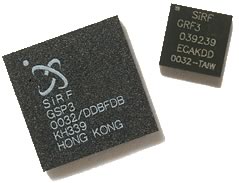
Looking at the SiRF III specs, we notice that the chipset is capable of receiving up to 20 channels (actually 12 maximum), has very low Hot/Warm/Cold start times and its accuracy reaches ~5m when WAAS mode is enabled.
2. GlobalSat BT-338
The BT-338 model is currently the most famous Globalsat product. The model was announced in March of 2005 and is a Bluetooth GPS device that can be paired with PDAs, laptops or even smartphones.
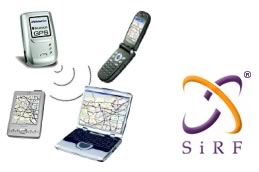
The BT-338 works under Windows, Mac, Palm, Pocket PC or Symbian!
Supporting the NMEA data protocol output, the BT-338 can be used with any
mapping, navigation, marine, aviation or topo software on the market.
- Features
1.SiRF Star III WAAS enabled high performance and low power consumption chipset
2.Communication with Host platform Via Bluetooth Serial Port Profile
3.Built-in ceramic patch antenna
4.Superior sensitivity for urban canyon and foliage environment
5.3 LEDs for power, GPS and Bluetooth status
6.Operation time: 17 hours in continuous mode
7.Bluetooth operation range: 10 metres
The embedded Star III 20-channel chipset from SiRF provides a quicker Time-To-Fix (TTF) and higher
satellite sensitivity, that can translate into greater accuracy for your software
applications. Another major plus of the BT-338 is its removable Li-ion battery (1700mAh) that can operate continuously from a full
charge for over 15 hours. The current price of the product is around US$143.99, as listed at the USGlobalsat website.
For our testing purposes, GlobalSat sent us the retail package that includes: the BT-338 GPS receiver itself, a protective carry case, an AC charger, a 12VDC car charger and finally, a CD-ROM with the corresponding software and user's manual.

The contents of the retail package are shown below:

Looking at the device, on the top we have the power switch, which needs to be pressed for 1 second to turn the device on or off.

On the left hand side (see photo below), we have the power-in jack, which is protected by a rubber cover.

On the rear, we can see the model ID, the SN, standards compliance, etc...

Removing the battery cover, you can gain access to the Li-Ion battery:

As mentioned in the features list above, there are three LEDs that indicate various conditions, described below.
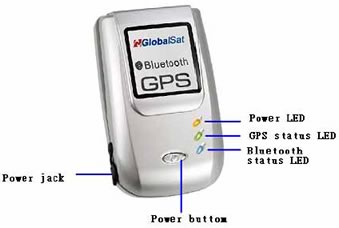

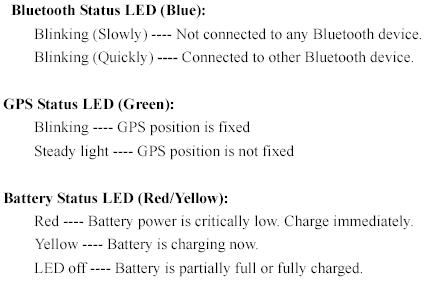
If the device is turned on and there is no Bluetooth connectivity with any device within 10 minutes, the BT-338 will turn off automatically, to maximize standby time. You don't need to worry about closing the BT-338 either, only to power it up! Its power consumption is low - in standby: 110 mA ~ 120 mA, while in operation: 130 mA ~ 140 mA.
The external dimensions of the BT-338 are 72.5mm x 40.4mm x 23mm with a weight of 75gr, making it truly portable and you can carry it with you always in case it's needed! The protective carrying case helps too.

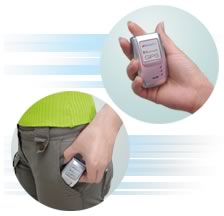
3. BT-338 Installation
In order to start using the BT-338, firstly you have to fully charge it. From our tests, it would need around 2~2.5 hours το fully charged, but remember its battery can last up to 17hours! After pressing the power button, you can move to your connected device, at our case a Dell Axim x50V with Windows Mobile 2003 SE. The installation process is clearly described at a included PDF file, but we will show some steps for your reference.
Start by accesing the bluetooth manager and tap New->Connect

The BT-338 will show up with the BT-GPS-316FB2 ID:
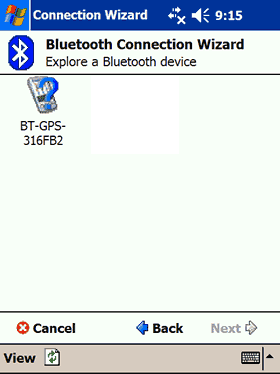
Press Next->Select BT-GPS COM Port -> Next
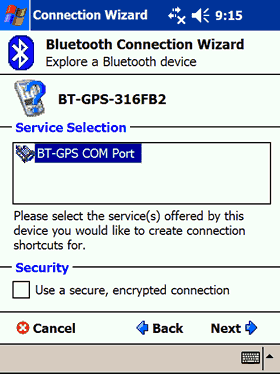
Done!

After accessing the BT Manager, press right click
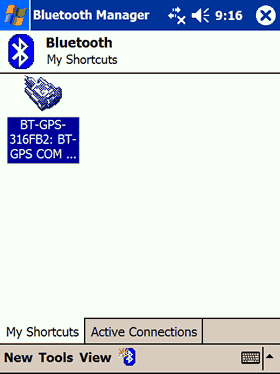
, select Connect
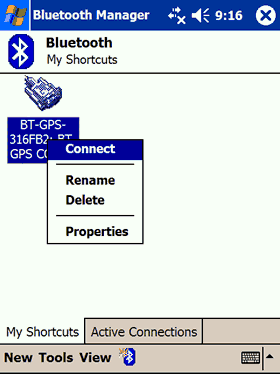
Finally, our BT-338 is connected with the Dell Axim x50V PDA and ready to use!
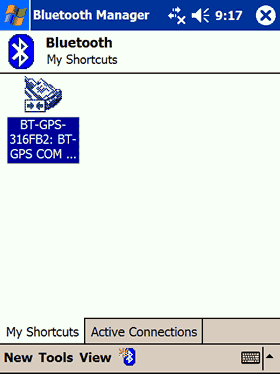
There are several details available about the activity of the BT port,

Globalsat suggests to use the included GPS Info software for checking if and how the BT-338 works. There is an executable file at the included CD-ROM disc, run it, then follow the instructions and will be installed at your PDA. While the included PDF manual suggests to look at COM5, our BT-338 found at COM7, make sure to select the communication speed (38400). Press the "Scan GPS" and if all goes well, you will see many numbers start scrolling down. Don't be afraid, its just what the receiver gets from the satellites.

After waiting few seconds, select the "GPS Info" tab to see several useful information about the satellites signal power, the current speed and co-ordinations. Our BT-338 works just fine even its placed at a window, real life tests later at this article...

Are we done? Not yet, lets check several other useful information, like the device firmware revision (latest know 3.1.1), with GPS Tweak. By using the special SiRF mode, we confirmed that our device had the 3.1.1 firmware:

4. GlobalSat SD-502
 SD-502 is a GPS Receiver with SDIO (Security Digital Input/Output) interface and an integrated
512MB built-in memory, which allows
you to easily organize, store and share files or documents. It also allows you to track signals and
large map data according to the mapping software usage.
SD-502 is a GPS Receiver with SDIO (Security Digital Input/Output) interface and an integrated
512MB built-in memory, which allows
you to easily organize, store and share files or documents. It also allows you to track signals and
large map data according to the mapping software usage.
Its cylindrical antenna can receive the signal from all directions (360
degrees). It satisfies a wide variety of applications, including car navigation, personal touring navigation
or tracking and even marine navigation purposes.
- Features
1. SiRF Star III high performance and low power consumption chipset
2. SD-502 has a built-in GPS omni directional antenna
3. LED to show GPS signal fix or searching
4. Built-in super capacitor to reserve system data for rapid satellite acquisition
5. SDIO interface
6. Operating platform: Pocket PC 2002/2003, Win CE, Win CE.Net, WM2003
7. Built-in memory size: 512MB
8. Base on Bsquare SDIO Now!
The embedded Star III 20-channel chipset from SiRF provides a quicker Time-To-Fix (TTF) and higher
satellite sensitivity, that can translate into greater accuracy for your software
applications. The current price of the product is around US$180.99, as listed over USGlobalsat website.
For our testing purposes, GlobalSat sent us the retail package that includes: the SD-502 GPS receiver and a CD-ROM with drivers and the user's manual.

The contents of the retail package are shown below:


On the rear we can see the model ID, the SN, etc...


The device draws power from the PDA and has only one led (rapid flash indicates located satellites, always on means no satellites tracked down).

The installation process is rather easy, just plug-in the SD-502 into a free SD slot. Below you can see the SD-502 as installed in a Dell Axim x50V PDA. Due to its size, you must be careful not to damage the device. The power consumption of the SD-502 is 90mA, while its physical dimensions are: 95 mm x 30 mm x 13 mm.



Please note the following compatibility list, before purchasing the SD-502. As you can see, most of the major PDA devices are supported:
Confirmed Compatible Devices v.1.32:
• Dell Axim X3 Pocket PC
• Dell Axim X30 Pocket PC
• Dell Axim X50 Pocket PC
• Dell Axim X50V Pocket PC
• Dell Axim X51V WinMobile5 (WM5)
• HP iPAQ rz1710
• HP iPAQ h1930 Pocket PC
• HP iPAQ h1940 Pocket PC
• HP iPAQ 1950
• HP iPAQ 2200
• HP IPAQ h2210
• HP IPAQ hx2410
• HP iPAQ 2750
• HP IPAQ rx3115
• HP IPAQ h4150
• HP IPAQ hx4700
• HP iPAQ h6315 Pocket PC
• Eten M500
• Mio 168
• T-Mobile MDA Compact
• Fujitsu LOOX 720
• Asus MyPal 730
• SPV M2000
• O2 XDA2
Devices listed above have been tested and proven to be compatible with the SD-502.
Non Compatible Devices:
• HP iPAQ h3970
• HP iPAQ hw6515
• Toshiba E800BT
• Qtek S100
5. SD-502 Installation
The installation process requires two steps. First, you have to install the included driver from the CD-ROM, or alternatively download an updated driver (v1.32) from the www.usglobalsat.com web site, supporting WM5 OS. If you install the SD-502 without first installing the driver, a warning message pops up:

For our tests, we used the included driver, v1.30, which worked perfectly with WM2003SE.
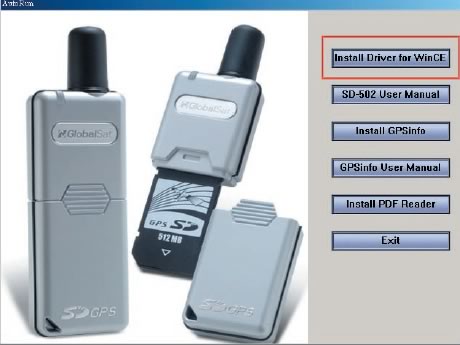

After installation, you can use the included GPSInfo software to check if your GPS is working properly. Note, that the SD-502 will take COM4 and you have to set the communications rate to 4800.
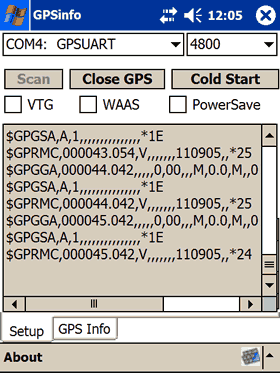
Lastly, we used GPSTweak to check the device firmware:
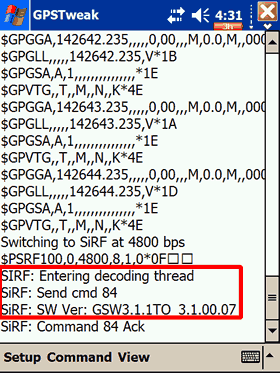
6. GlobalSat BC-337
 Unlike traditional GPS receivers which require separate antennas or wires, the WAAS enabled BC-337 is an integrated receiver with a built-in patch antenna, designed to fit directly into the Compact Flash or PCMCIA slot. The BC-337 design is based on the SiRF Star III with wireless consumer applications in mind; it will give accurate readings from up to 20 channels.
Unlike traditional GPS receivers which require separate antennas or wires, the WAAS enabled BC-337 is an integrated receiver with a built-in patch antenna, designed to fit directly into the Compact Flash or PCMCIA slot. The BC-337 design is based on the SiRF Star III with wireless consumer applications in mind; it will give accurate readings from up to 20 channels.
The BC-337 is truly transportable. Insert it into your PDA and place it in a convenient spot in your car and enjoy the benefits of using your additional mapping software for intelligent route calculation and voice-prompted, turn-by-turn navigation instructions.
- Features
1. CFA compliant.
2. WAAS Enabled SiRF Star III/LP low power All-in-View high performance 20-parallel channels.
3. Supports Standard NMEA 0183 command: GGA, GSA, GSV, RMC, GLL, VTG.
4. SingleSat updates in reduced visibility.
5. Superior urban canyon performance.
6. FoliageLock for weak signal tracking.
7. Optional external antenna.
8. Built-in Antenna for high sensitivity to satellite signal.
9. LED indicator for GPS fix or not fix.
The embedded Star III 20-channel chipset from SiRF provides a quicker Time-To-Fix (TTF) and higher
satellite sensitivity, that can translate into greater accuracy for your software
applications. The current price of the product is around US$111.99, as listed on USGlobalsat's website. Additionally, you can buy the external antenna (US$16.99) and the PCMCIA Adapter (US$8.99).
For our testing purposes, GlobalSat sent us the retail package that includes: the BC-337 GPS receiver, the AT-65-MMCX External Antenna, a PCMCIA Adapter Card , a cable suction cup clip and finally a CD-ROM (User Guide, Drivers, Utilities, etc…)

The contents of the retail package are shown below:


On the rear we see the model ID, SN, and place of manufacture.

The device draws power from the PDA and has only one red led (blinking: GPS has a fix, solid light: GPS does not have a fix.)

On the right, you can find a jack for the external antenna, which can be used to increase received signal strength.

The external antenna is long enough, around 5 meters!


Below you can see the BC-337 as installed on a Dell Axim x50V PDA. Due to its size, be careful not to damage the device. The power consumption of the BC-337 is 90mA , while its physical dimensions are 83 mm x 42.8 mm x 13.3 mm.



Please keep in mind that the device is not supported by the WM5 OS, at least according to current information posted on the Globalsat website.
- Installation
The installation process is very easy, since no special drivers are required. Just install the BC-337 in a free CF slot and open the GPSInfo software to check if your GPS is working properly. Note, that the BC-337 will take COM4 and you have to set the communications rate to 4800.

Lastly, we used GPSTweak to check the device firmware:

7. Tests - Day 1
We tested all of GlobalSat's GPS devices with a Dell Axim X50v. We recorded all produced data for a pre-selected route with VisualGPSce (free edition) and later analyzed it with GPSLog. In order to measure the TTFF tests ("Time to First Fix" which is the time it takes for a GPS to determine its current position), we used GPSInfo "Cold Start" function and measured the time with a chronometer. All tests ran continuously, under the same environmental conditions (night, cloudy weather, 6~8°) and all installed in an Audi, model A4 2004.
| Model |
BT-338 |
SD-502 |
BC-337 |
| Fix |
Invalid |
0 |
0 |
0 |
| 2D |
0 |
0.2% |
1.0% |
| 3D |
100 % |
99.2% |
99.9% |
| Satellites |
Average (in view) |
9 |
9.93 |
10.00 |
| Average (in use) |
7.14 |
5.43 |
5.61 |
| Average Signal Level (in dB) |
Maximum per Satellite |
46.88 |
40.17 |
41.17 |
| Average per Satellite |
39.64 |
32.12 |
32.81 |
The results speak for themselves. The best performance comes from the BT-338, which had the highest average satellites in use and the highest average signal level per satellite. Even though on average, it didn't "view" more than 9 satellites, it had the highest average in-use time (7.14). Even though the BC-337 had good signal levels, it needed an extra fix, possibly due to a bad reception. It managed an average of 10 satellites in view (we saw up to 12) but had an average satellite in use of only 5.61. Lastly, the SD-502 had the lowest overall performance, both in use and in average signal levels.
Using VisualGPSXP, we made several plots, mostly for the altitude. As you will see, the three GPS devices produced slightly different results:

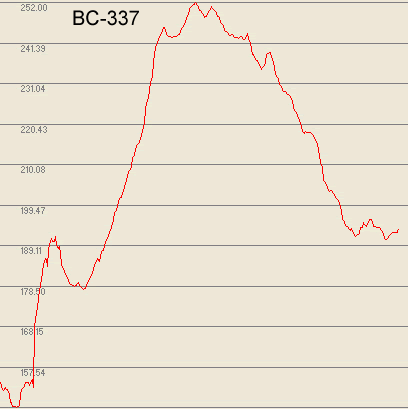

Not all Globalsat GPS receivers reported the same altitude for the same course...
For all previous tests, all receivers were installed on the car's dashboard, in clear and direct view of the satellites. However, it is possible, especially with the BT-338, to have it installed in the front glove compartment. Should you expect any difference in the performance? The answer is yes, as the following table shows:
| Model |
BT-338 |
BT-338 in glove box |
| Time to First Fix (TTFF) |
Secs |
<45sec |
<45sec |
| Fix |
Invalid |
0 |
0 |
| 2D |
0 |
0 |
| 3D |
100 % |
100% |
| Satellites |
Average (in view) |
9 |
9 |
| Average (in use) |
7.14 |
7.11 |
| Average Signal Level (in dB) |
Maximum per Satellite |
46.88 |
39.25 |
| Average per Satellite |
39.64 |
30.00 |
Apart from the slightly lower performance, there is also a change in the reported altitude...

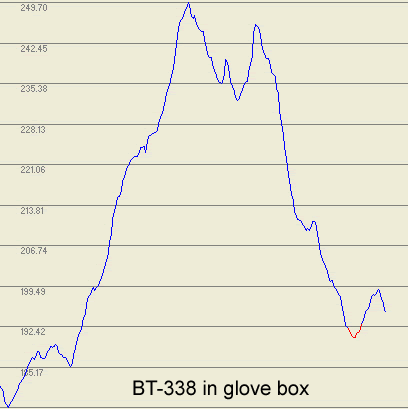
8. Tests - Day 2
We tested all GlobalSat GPS devices with a Dell Axim X50v. We recorded all produced data for a pre-selected route with VisualGPSce (free edition) and later analyzed it with GPSLog. In order to measure the TTFF tests ("Time to First Fix" which is the time it takes for a GPS to determine its current position), we used the GPSInfo "Cold Start" function and measured the time with a chronometer. All tests ran continuously, under the same environmental conditions (night, cloudy weather, 6~8°) and all installed in an Audi, model A4 2004.
After the first day, our curiousity had been aroused and so, we performed new series of tests, including the BC-337's external antenna, which is supposed to increase the sensitivy and give better results than the originally attached antenna. We rested all three Globalsat GPS products, again with the same route and same enviromental conditions. Note, that there are three BC-337 results, the first with the attached antenna, the second with the external antenna installed on the car's dashboard and the PDA sitting in the passenger's seat, and lastly with the external antenna installed on the car's dashboard and the PDA situated so that the built-in antenna could also see the sky. The posted TTFF times are the average of the three measurements.
|
BT-338
|
SD-502
|
BC-337
|
BC-337 only antenna
|
BC-337 + antenna
|
|
Time to First Fix (TTFF)
|
Secs
|
43.33sec
|
?
|
66.66
|
36
|
36.33
|
|
Fix
|
Invalid
|
0
|
0
|
0
|
0
|
0
|
|
2D
|
0
|
5.1
|
0
|
0
|
0
|
|
3D
|
100
|
94.9
|
100
|
100
|
100
|
|
Satellites
|
Average (in view)
|
10
|
9
|
9.98
|
9
|
9
|
|
Average (in use)
|
6.80
|
5.15
|
7.82
|
7.95
|
7.93
|
|
Average Signal Level (in dB)
|
Maximum per Satellite
|
47.14
|
39.17
|
40.13
|
48.13
|
47.00
|
|
Average per Satellite
|
39.28
|
29.00
|
32.81
|
40.14
|
39.83
|
The results are very interesting. Starting with the TTFF times, we notice that the SD-502 had problems acquiring satellites and long fix times, some were up to 120secs! The BT-338 delivered what it promises <45sec, while the BC-337 with the external antenna, really make a difference at 36secs!
The BT-338 may had the higher average in view satellites but average used less than BC-337 (with or without the external antenna).The SD-502 gets the last place with only 5.15 average in use satellites. Lastly, the BT-338 shows its teeth, it reached 47.14 dB maximum and 39.28 dB average per satellite. The BC-337 comes second and the SD-502 last. When we installed the external antenna, the BC-337 gave the best performance with 40.14 dB (average per satellite).

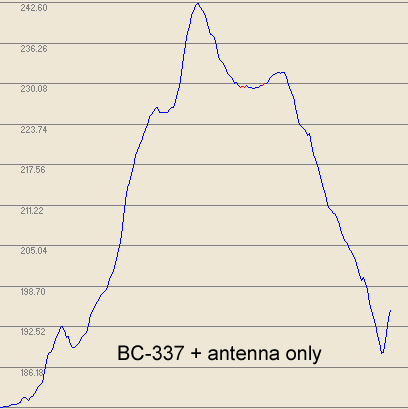

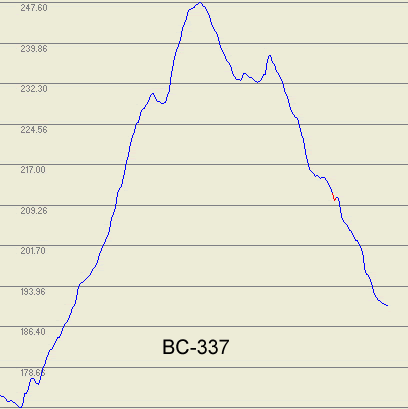

Looking at the altitude graphs, we can see that BT-338 and BC-337 gave similar numbers, while BC-337 with external antenna seems to further increase the detail of the course. The SD-502 reported rather higher altitudes...
Looking at the results of both days, we can say that the sensivity of each GPS receiver varies from day to day, hence weather conditions, but in general the BC-337 with external antenna, seems to be the most preferead solution. Of course the BT-338 is very close and will satisfy users with the ability to use Bluetooth connection interface :-)
9. Conclusion
 Without any doudbt the tested Globalsat GPS products are very good products and will satisfy their buyers. Each one has its own buy group, depending upon the needs of user. If someone wants to use a GPS device at both PDA and Laptop, then the BT-338 or BC-337 are the best choices. If the connection interface is Secure Digital, then SD-502 is a perfect match.
Without any doudbt the tested Globalsat GPS products are very good products and will satisfy their buyers. Each one has its own buy group, depending upon the needs of user. If someone wants to use a GPS device at both PDA and Laptop, then the BT-338 or BC-337 are the best choices. If the connection interface is Secure Digital, then SD-502 is a perfect match.
The BT-338 will probably be the best choice for most users, since it unitlializes a strong battery, being able to powerup to 17hours the device, features auto-turn off and showed excellent performance either installed at the car panel or inside a glove box. Its small external sizes making it truly portable, so you can carry it with you anywhere.
The BC-337 uses the compact flash interface so it can connect at PCs and PDAs without any special problem. When someone use the included external antenna will enjoy perfect performance with low TTFF times and high sensitivity...Lastly the SD-502 is a product, mostly aimed for PDA users, it also includes a 512MB on board memory for storing your maps or logged data. While its performance was not the best at this roundup, we can live with it.
BT-338
The Positive
- Complete retail package
- Car charger is included
- Very good performance
- Easy installation but user should read before the included PDF
- Powers it self off automatically!
- Included battery can last up to 17hours!
- Small dimensions and low weight make it portable
The Negative
- No input jack for external antenna

BC-337
The Positive
- Input jack for external antenna
- Very easy installation process
- Complete retail package
- Includes PCMCIA adapter
- Can be used at both laptops and PDAs
- Very good performance (especially with external antenna installed)
The Negative
- Not as fast and accurate as BT-338 (without external antenna)
- Doesn't work under WM5, be careful!

SD-502
The Positive
- Complete retail package
- Includes 512MB storage on board
- Small dimensions
The Negative
- Average performance, its TTFF times are rather high
- Can be used only with PDA devices
- Check the compatibility list before buying it, be careful!